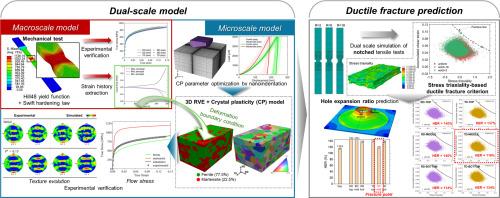基于微观结构的韧性断裂预测序列双尺度方法
IF 7.1
1区 工程技术
Q1 ENGINEERING, MECHANICAL
International Journal of Mechanical Sciences
Pub Date : 2024-09-13
DOI:10.1016/j.ijmecsci.2024.109719
引用次数: 0
摘要
本研究提出了一种新颖的双尺度有限元方法,用于建立铁素体-马氏体双相钢(DP)的微观结构韧性断裂准则。在宏观尺度上,采用随硬化速率变化的各向异性塑性模型模拟材料的变形历史。同时,在微观尺度上,采用基于位错密度的晶体塑性模型模拟双相钢代表性体积元素(RVE)内的变形,RVE 是在等离子体聚焦离子束/电子反向散射衍射系统的辅助下,利用断层扫描技术构建的。RVE 模拟结果与实验测量的机械性能和微观结构变化进行了验证。从宏观模型中提取的断裂起始点的局部变形历史被用作微观 RVE 模拟的边界条件;顺序双尺度方法。这些模型适用于具有不同缺口半径的试样,在断裂发生时产生不同的局部应力三轴度和累积剪切应变。这一过程建立了韧性断裂标准,并在扩孔实验中进行了进一步测试,结果表明该标准与实验数据密切吻合。这种顺序双尺度分析方法通过结合现实的微观结构有效地预测了多相金属材料的变形行为,同时最大限度地降低了计算成本。因此,所提出的韧性断裂预测技术提供了一种稳健的方法,广泛适用于各种金属材料。本文章由计算机程序翻译,如有差异,请以英文原文为准。

Sequential dual-scale approach for microstructure-informed ductile fracture prediction
This study presents a novel dual-scale finite element method to establish a microstructure-informed ductile fracture criterion for ferrite–martensite dual-phase (DP) steel. At the macroscale, an anisotropic plasticity model with rate-dependent hardening was employed to simulate the material's deformation history. Simultaneously, at the microscale, a dislocation density-based crystal plasticity model was utilized to simulate deformation within a representative volume element (RVE) of the dual-phase steel, constructed using tomography aided by a plasma-focused ion beam/electron backscatter diffraction system.
The material properties of the ferrite and martensite phases were determined through X-ray diffraction (XRD) analysis and load-displacement measurements obtained via nanoindentation for each phase. The RVE simulation results were validated against experimentally measured mechanical properties and microstructural changes. The local deformation history at the fracture initiation site, extracted from the macroscale model, was used as boundary conditions for the microscale RVE simulation; sequential dual-scale approach. The models were applied to specimens with varying notch radii, generating different local stress triaxialities and accumulated shear strains at fracture onset. This process allowed the establishment of a ductile fracture criterion, which was further tested in a hole expansion experiment, demonstrating close alignment with experimental data.
This sequential dual-scale analysis effectively predicts the deformation behavior of multiphase metallic materials by incorporating realistic microstructures while minimizing computational costs. Consequently, the proposed ductile fracture prediction technique offers a robust method with broad applicability across various metallic materials.
求助全文
通过发布文献求助,成功后即可免费获取论文全文。
去求助
来源期刊

International Journal of Mechanical Sciences
工程技术-工程:机械
CiteScore
12.80
自引率
17.80%
发文量
769
审稿时长
19 days
期刊介绍:
The International Journal of Mechanical Sciences (IJMS) serves as a global platform for the publication and dissemination of original research that contributes to a deeper scientific understanding of the fundamental disciplines within mechanical, civil, and material engineering.
The primary focus of IJMS is to showcase innovative and ground-breaking work that utilizes analytical and computational modeling techniques, such as Finite Element Method (FEM), Boundary Element Method (BEM), and mesh-free methods, among others. These modeling methods are applied to diverse fields including rigid-body mechanics (e.g., dynamics, vibration, stability), structural mechanics, metal forming, advanced materials (e.g., metals, composites, cellular, smart) behavior and applications, impact mechanics, strain localization, and other nonlinear effects (e.g., large deflections, plasticity, fracture).
Additionally, IJMS covers the realms of fluid mechanics (both external and internal flows), tribology, thermodynamics, and materials processing. These subjects collectively form the core of the journal's content.
In summary, IJMS provides a prestigious platform for researchers to present their original contributions, shedding light on analytical and computational modeling methods in various areas of mechanical engineering, as well as exploring the behavior and application of advanced materials, fluid mechanics, thermodynamics, and materials processing.
 求助内容:
求助内容: 应助结果提醒方式:
应助结果提醒方式:


